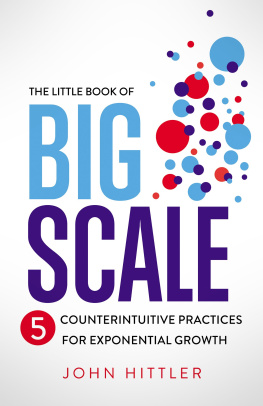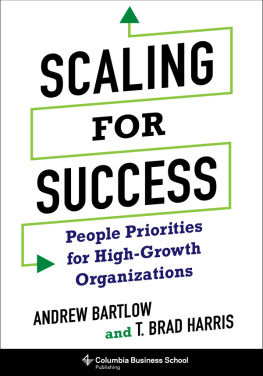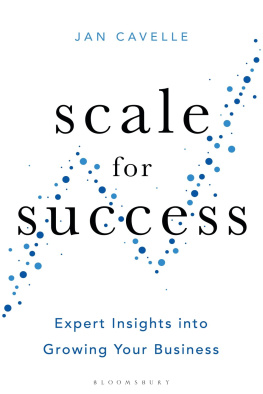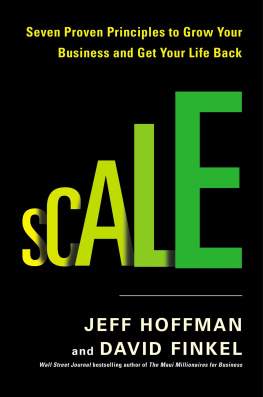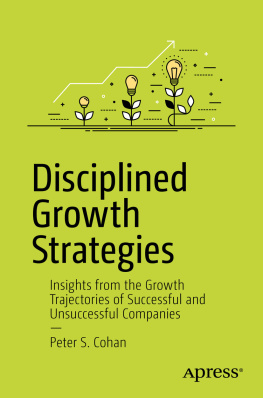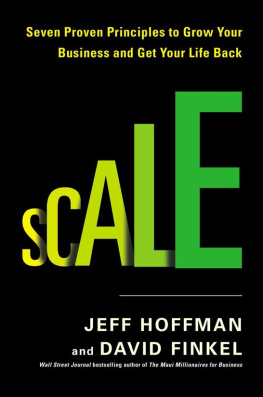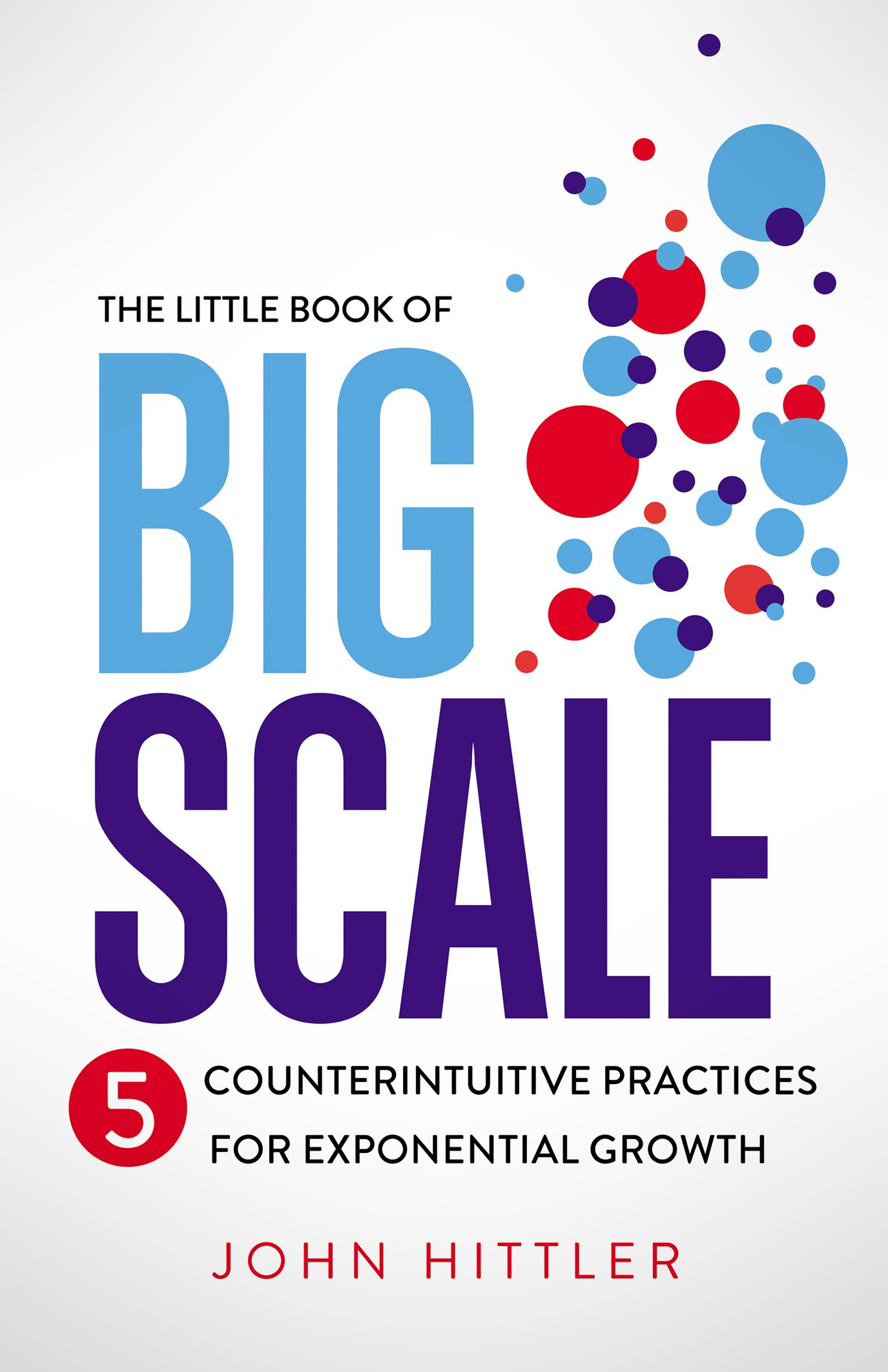


copyright 2022 john hittler
All rights reserved.
the little book of big scale
5 Counterintuitive Practices for Exponential Growth
isbn
978-1-5445-3514-2 Hardcover
978-1-5445-3513-5 Paperback
978-1-5445-3515-9 Ebook

Contents

This book is dedicated to the courageous entrepreneurs who continue to defy the odds, take on big challenges, and play in the hard-scrabble game of business.
Win or lose, you inspire your teams and customers
with your passion, vision, and dedication to your craft.
Introduction
Why a Book About Scaling Now?
Winning isnt everything; its the only thing.
Vince Lombardi
Venture Capitalists, entrepreneurs, private equity firms, and small retail shoe store owners have one thing in common: they would like their endeavors to result in higher growth and profits.
More specifically, they seek profitability with the prospect for continually higher growth in revenue, net margin, employee headcount, or user acquisitionsfast growth nonetheless. The Holy Grail is scaling , where all investors and most employees benefit greatly.
Two premises exist when discussing the idea of scaling. The first is that scaling is simply a form of changefrom what you are doing currently (or more precisely, think you are doing ) to growing 50% faster than your industry, year over year. And heres the rub: If youre copying what you think a competitor or friend is doing to scale, youre likely to fail. After all, you are not Elon Musk or Jeff Bezos, and your company is not built like theirs.
Your scaling story will need a framebuilt and nourished by you and your team, customized to your specific talents, products, people, and customers. As a rule, the vast majority of humans prefer predictability and stability. Your own scaling story will depend upon you leaning into almost constant uncertainty. It often will look a bit counterintuitive, since your explanation after the fact will sound simple and easy to others. In reality, your path will be anything but what others can easily duplicate. Much like you cannot simply copy a successful model (otherwise, everyone would scale), your journey will be uniquely yours to enjoy.
The second premise is that scaling exists fundamentally as a leadership activity rather than a sales activity. If not, every company would simply focus on doubling sales every year and producing twice as much product. If scaling were that logical or linear, we would all issue shares for our upcoming IPOs. Scaling involves the courage to charge into an unexplored niche, or even a gigantically inefficient marketplace. Take banking in the past decade. Multiple companies have taken a large chunk of the banking business away from traditional players. These companies are now household names: PayPal, Venmo, Revolut, Chime, Box, Plaid, Brexthe list is long. All of that growth and value creation started as declarations from leaders. Those declarations came from two fundamental things: 1) a complaint about what was lacking, and 2) a vision of what might be possible.
Leadership jump-starts scaling (or prevents it), and that leadership generally works best with the CEO out in front of the team.
So Why Now?
I wrote The Little Book of Big Scale for those willing to take on inherent risks, invest a sizable chunk of capital, and then work insanely long and hard hours to create a success. Call them disrupters, entrepreneurs, or simply innovators. Whatever the name, they deserve all of the prizes for effectively scaling. Those fortunate enough earn the accolades, notoriety, and also the check that usually accompanies scaling. For CEOs, the new reputation as a successful entrepreneur is often the most prized trophy, as they join an exclusive club.
But heres the conundrum. For every company that hires well, develops an effective culture, and designs a service or product with promise, there are nine companies that fail using the exact same recipe. How do you tell the differences between the one-in-ten who succeeds and the nine-in-ten who do not? Postmortems can help, but the tendency is to shrug your shoulders and just call it random luck. Certainly good fortune and timing can play a part, but there are usually equal amounts of inopportune timing and poor luck too, so what really makes a success in one company but not a similar success in another?
This book explores some of the counterintuitive, not so obvious, and predictably useful rules and practices that scale effectively over time, regardless of product, service, industry, culture, or size. These practices were drawn from CEOs successful at scaling. I break down their practices into simple form such that you can use them in your companywith some basic customization of your own.
This book offers notions and ideas that most companies do not employ, strategies that are often just the opposite of what most companies do. The key is that the counterintuitive practices discussed are tied purposely to scaling, nothing else. Some practices function better with a culture-first bias, and others work better when companies focus primarily on hiring talent devoid of the cultural implications. I also introduce structure, separate from culture and talent, as an often-overlooked part of rapid growth. The practices presented in this book show effectiveness at every size, and the CEOs explain how to scale the practices from garage-band-sized companies to large companies pursuing IPOs. Most importantly, instructions are provided on how you can implement and customize these counterintuitive practices into your company.
Youll meet the CEOs who are successfully scaling, how they are doing it, and, perhaps most importantly, why they choose to go against the herd, or counterintuitively create scale. Considering the historical one-in-a-million chance of success following the existing recipe, taking a counterintuitive approach increases your chances of scaling and actually makes great statistical sense. If not, the traditional approach would yield a much higher success rate and become the easier bet to place.
Is There a Recipe?
What if companies could dramatically increase their odds of success simply by engaging counterintuitive practices rather than following (much) more popular notionsthat fail at a very high rate?
Succeeding often occurs in business in counterintuitive ways. Just to play in the entrepreneurial game most likely will take you four or five years, marked by very long hours, sleepless nights, stress, and the absence from some key family events. So then, why not win the game, or at least dramatically increase your chances?
After having founded nine companies and one charitable foundation myself, seven of the nine companies eventually (mercifully, in some cases) failed. Still, people console me that two for nine is a better success rate than most billionaire venture capitalists produce. Coming close and eventually failing hurts, especially if someone else beats you to the win. But failures also provide great lessons on what to avoid.

